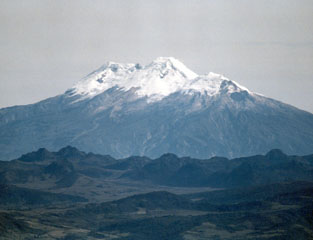Report on Nevado del Huila (Colombia) — 21 October-27 October 2009
Smithsonian Institution / US Geological Survey
Weekly Volcanic Activity Report, 21 October-27 October 2009
Managing Editor: Sally Sennert.
Please cite this report as:
Global Volcanism Program, 2009. Report on Nevado del Huila (Colombia) (Sennert, S, ed.). Weekly Volcanic Activity Report, 21 October-27 October 2009. Smithsonian Institution and US Geological Survey.
Nevado del Huila
Colombia
2.93°N, 76.03°W; summit elev. 5364 m
All times are local (unless otherwise noted)
The Washington VAAC reported a possible eruption from Nevado del Huila on 20 October. An ash plume was seen on satellite imagery drifting 45 km S and INGEOMINAS had reported increased seismicity. Another ash cloud was seen on satellite imagery drifting S later that day.
Based on web camera views, INGEOMINAS reported that on 21 October continuous gas emissions rose from Nevado del Huila and pulses of ash emissions produced plumes that drifted E. Observations during an overflight on 23 October revealed that gas-and-ash emissions originated from two locations. The area of greater discharge was between Pico Central and the lava dome, while fewer emissions came from the fissure that opened in April 2007, NE of Pico Central. Lava-dome growth was concentrated on the N end of the lava dome, an area also exhibiting a thermal anomaly detected with a thermal imaging camera. The Alert Level remained at II (Orange; "probable eruption in term of days or weeks"). Ashfall and sulfur odors were reported in several inhabited areas on 23 and 24 October.
Based on analyses of satellite imagery and information from INGEOMINAS, the Washington VAAC reported that on 24 October an eruption produced an ash plume that rose to an altitude of 9.1 km (30,000 ft) a.s.l. and drifted WSW. During 25-26 October, thermal anomalies were seen on satellite imagery. A plume drifted WSW on 25 October and a gas-and-ash plume drifted 90 km NW and SW on 26 October.
Geological Summary. Nevado del Huila, the highest peak in the Colombian Andes, is an elongated N-S-trending volcanic chain mantled by a glacier icecap. The andesitic-dacitic volcano was constructed within a 10-km-wide caldera. Volcanism at Nevado del Huila has produced six volcanic cones whose ages in general migrated from south to north. The high point of the complex is Pico Central. Two glacier-free lava domes lie at the southern end of the volcanic complex. The first historical activity was an explosive eruption in the mid-16th century. Long-term, persistent steam columns had risen from Pico Central prior to the next eruption in 2007, when explosive activity was accompanied by damaging mudflows.
Sources: Servicio Geológico Colombiano (SGC), Washington Volcanic Ash Advisory Center (VAAC)

